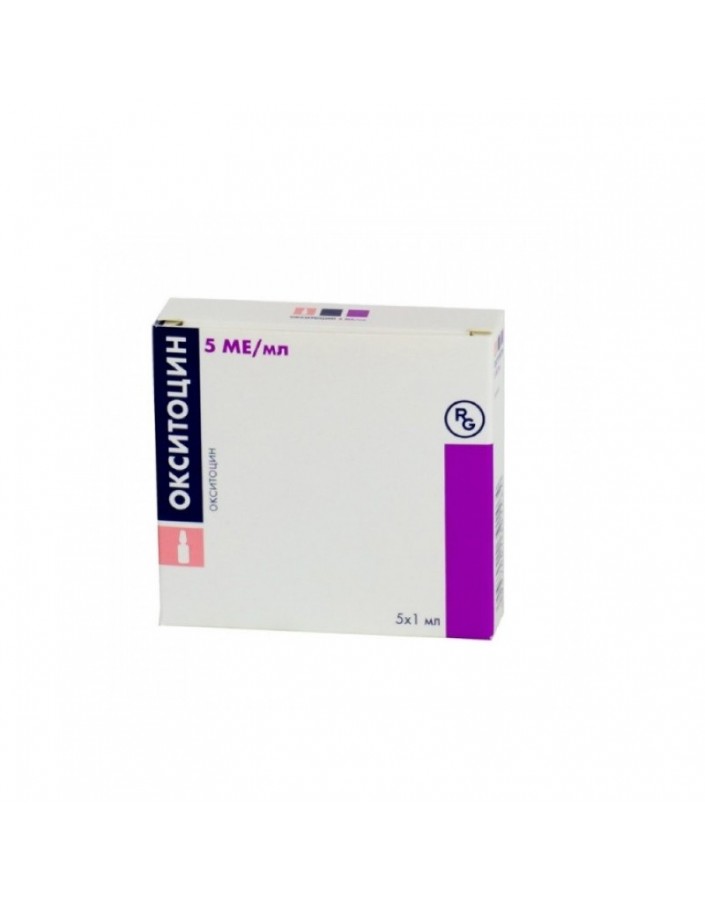




Security policy (edit with Customer reassurance module)

Delivery policy (edit with Customer reassurance module)

Return policy (edit with Customer reassurance module)
Hormonal agent, a polypeptide analogue of the hormone of the posterior lobe of the pituitary gland. It has uterotonic, stimulating generic activity and lactotropic action. It has a stimulating effect on myometrium (especially at the end of pregnancy, during labor and immediately during delivery). Under the influence of oxytocin, the permeability of cell membranes for Ca2 + increases, the resting potential decreases and their excitability increases (a decrease in membrane potential leads to an increase in the frequency, intensity and duration of contractions). It stimulates the secretion of breast milk, increasing the production of prolactin by the anterior pituitary gland. Reduces myoepithelial cells around the alveoli of the mammary gland, stimulates the flow of milk into the major ducts or sinuses, helping to enhance the separation of milk. Practically devoid of vasoconstrictor and antidiuretic action (only in high doses), does not cause contraction of the muscles of the bladder and intestines. The effect occurs after 1-2 minutes with s / c and in / m the introduction, lasts 20-30 minutes; with a / in - after 0.5-1 min, intranasally - within a few minutes.
For the excitation and stimulation of labor activity (primary and secondary weakness of labor, the need for early delivery due to preeclampsia, rhesus-conflict, fetal fetal death; postponed pregnancy, premature rupture of amniotic fluid, birth management in pelvic presentation). For the prevention and treatment of hypotonic uterine bleeding after an abortion (including during long periods of pregnancy), in the early postpartum period, and to accelerate the postpartum involution of the uterus; to enhance the contractility of the uterus during cesarean section (after removal of the afterbirth). Hypolactation in the postpartum period. Painful premenstrual syndrome, accompanied by edema, weight gain.
Hypersensitivity; narrow pelvis (anatomical and clinical), transverse and oblique position of the fetus, facial presentation of the fetus, premature birth, threatening uterine rupture, scarring in the uterus (after previous cesarean section, uterus surgery), excessive stretching of the uterus, uterus after multiple births, partial Placenta previa, uterine sepsis, invasive cervical carcinoma; hypertonus of the uterus (arising not during childbirth), fetal compression, arterial hypertension, chronic renal failure.
In / in, in / m, in the wall or vaginal part of the cervix, intranasally (using a pipette). For the initiation of labor - in / m, 0.5-2 IU; if necessary, repeat the injection every 30-60 minutes. Induction of labor: in / in drip, 10 IU of oxytocin per 1 liter of 5% dextrose solution, with the development of excessive uterine contractions, slowing the infusion quickly leads to a decrease in myometrial activity.The introduction begins with 5-8 drops / min, followed by an increase in speed depending on the nature of labor, but not more than 40 drops / min. During infusion, constant monitoring of uterine activity and fetal heart rate is necessary. Treatment of imminent or incomplete abortion: in / in drip, 10 IU of oxytocin per 500 ml of 5% dextrose solution with a speed of 20-40 drops / min. For the prevention of hypotonic uterine bleeding, oxytocin is injected intramuscularly, 3-5 IU 2-3 times a day every day for 2–3 days, it is acceptable to administer 10 IU immediately after the placenta is removed. For the treatment of hypotonic uterine bleeding, 5-8 IU is administered 2-3 times a day for 3 days. If necessary, injected into / in the drip of 10-40 IU of oxytocin dissolved in 100 ml of donor blood. Strengthening the separation of milk (to prevent mastitis due to stagnant milk): in / m - 2 IU. To stimulate lactation in the postpartum period - in / m or intranasally, 0.5 IU for 5 minutes before feeding. At birth in the pelvic presentation - 2-5 IU. Premenstrual syndrome is intranasal, from the 20th day of the cycle to the 1st day of menstruation. During cesarean section (after removal of the afterbirth), a dose of 3-5 IU is injected into the uterus wall.
Bradycardia (in mother and fetus), decrease in blood pressure, shock, or increase in blood pressure and subarachnoid hemorrhage, cardiac arrhythmias (including in the fetus); bronchospasm; nausea, vomiting, water retention; neonatal jaundice, decrease in fibrinogen concentration in the fetus, allergic reactions. Overdose. Symptoms: fetal compression, fetal asphyxia, fetal bradycardia, postpartum hemorrhage, uterus tetanus, uterine rupture, uteroplacental hypoperfusion, hypoxia, hypercapnia, fetal death, birth injuries of the fetus, water intoxication, convulsions. Treatment: drug withdrawal, reduction of fluid intake, forced diuresis, hypertonic NaCl solution, normalization of electrolyte balance, barbiturates (with caution), careful observation.
Apply only under the supervision of a doctor in a hospital under the control of contractile activity of the uterus, fetal condition, blood pressure and the general condition of the woman.
Oxytocin enhances the pressor effect of sympathomimetic amines. In combination with MAO inhibitors, the risk of increasing blood pressure increases. Halothane and cyclopropane increase the risk of arterial hypotension.